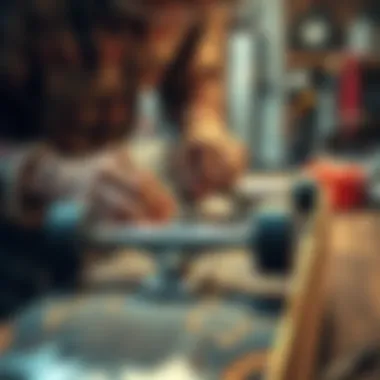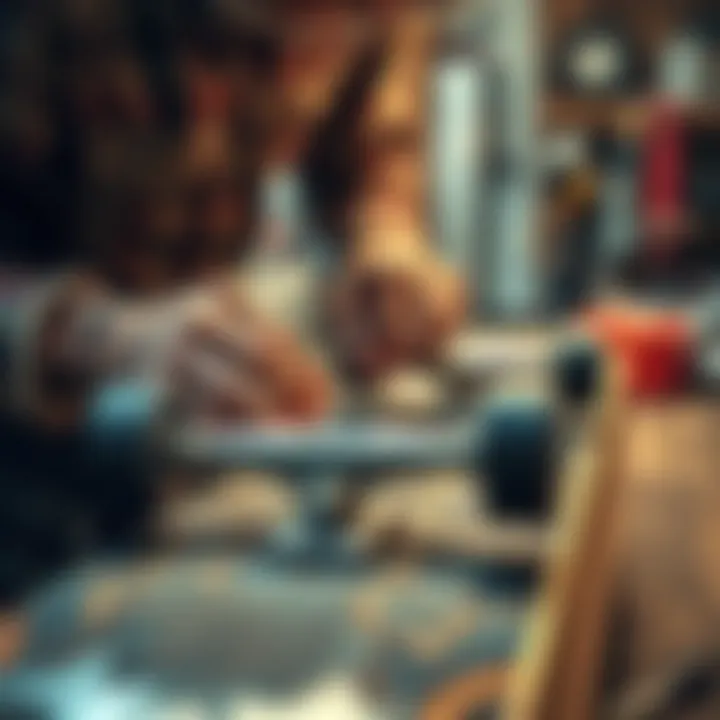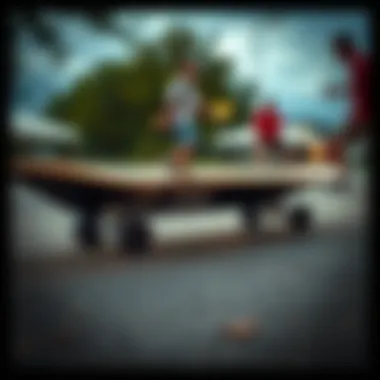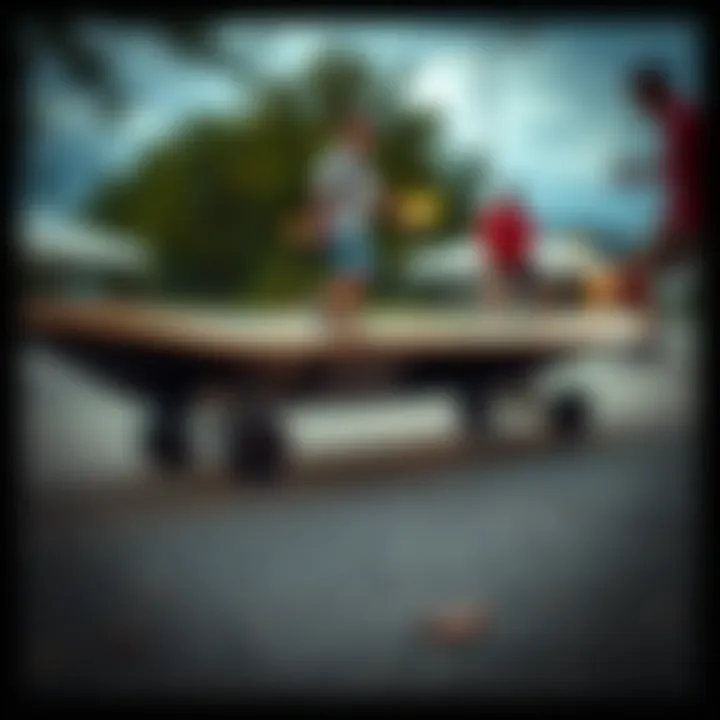Crafting Your Unique Skateboard: A Complete Guide


Intro
Building your own skateboard is not just a hobby; it’s an adventure that allows you to express your personality while enjoying the thrill of riding. The beauty of customizing your own skateboard lies in the ability to merge functionality with creativity. Each component, from the deck to the wheels, can be tailored to your liking, reflecting not just your style but also enhancing your performance on the board. In this guide, we will delve into the essentials of crafting a custom skateboard, unpacking various materials, design choices, and assembly techniques that may align with your individual tastes. Whether you’re a seasoned pro or a rookie looking to take the plunge, there’s a lot to know and even more to create.
Skateboarding Techniques
When it comes to skateboarding, mastering the techniques can drastically impact your riding experience. A solid understanding of fundamental tricks and maneuvers not only builds confidence but also elevates your overall enjoyment on the board.
Essential Tricks for Beginners
For those new to skateboarding, it’s vital to start with the basic tricks that lay the foundation for more complex skills later on. Here are some must-try moves:
- Ollie: This trick involves popping the tail of the skateboard and using your back foot to jump, allowing you to clear obstacles. Mastering the Ollie opens the door to various other tricks.
- Kickflip: Once you’ve nailed the Ollie, introduce a flip. This involves flipping the board with your front foot while in mid-air, creating a stylish move that can impress onlookers.
- Shuvit: This is a simpler trick where you make the skateboard spin 180 degrees beneath you while keeping your feet over it.
These tricks offer a solid grounding, ensuring beginners can feel accomplished as they navigate their early days of skating.
Advanced Maneuvers for Experienced Skaters
For those who have been skating for a while, pushing the limits is where the real fun begins. Here are some advanced techniques:
- Heelflip: Similar to the kickflip, but in this case, you use the heel of your foot to spin the board instead of the toes.
- 315-degree Shuvit: A spin that’s a bit more complicated but significantly advances your skateboarding skills, creating stylish flair.
- Blunt Slide: Balancing on the tail of your board while sliding a rail or ledge demands precision and technique.
Mastering these moves not only impresses fellow skaters but also contributes to a richer skating thrill.
"Remember, consistent practice and patience is key - don't rush the learning process!"
As the skateboard culture emphasizes individuality, the tricks you choose to master also play into your unique skating style. The goal is to create a personal flair while enjoying the journey.
Gear and Equipment Reviews
The importance of the right gear can’t be overstated when building your custom skateboard and refining your skateboarding skills. Here’s a closer look at the essential equipment that every skater should consider.
Top Skateboards for Every Skill Level
When selecting a skateboard, it’s crucial to choose one that matches your experience. Here are some excellent options:
- Element Skateboards: Known for their durability, Element boards are great for beginners and intermediate skaters.
- Santa Cruz Skateboards: Offering a wide variety of designs, these boards are robust and fit for experienced skaters.
- Baker Skateboards: If you’re looking for stronger decks, Baker is a fantastic choice, catering well to those who love to perform tricks.
Each of these brands has something unique to offer, depending on your skill level and personal taste.
Protective Gear: Importance and Recommendations
Skateboarding can involve a few tumbles, even for the most proficient riders. Having the right safety gear is non-negotiable:
- Helmets: Essential for protecting your head. Brands like Pro-Tec offer great options.
- Knee and Elbow Pads: Always a good idea to invest in quality pads, especially for beginners.
- Wrist Guards: These can help prevent injuries during falls, aiding in the long-term enjoyment of the sport.
As unique as your custom skateboard will be, ensuring you are protected during your rides is equally important.
In summary, skateboarding is more than just a sport; it's a community and an art form. The techniques, gear, and creativity involved create a rich tapestry of experiences that each skater can uniquely contribute to. Stay tuned as we explore the nuances of materials and assembly techniques, helping you make the best choices for your next custom build.
Preface to Custom Skateboards
Building your own skateboard is not just about putting pieces together; it’s an opportunity to reflect your personality and style. The appeal of custom skateboards lies in the unique relationship between the rider and their board. When you craft your own skateboard, you engage in a creative process that combines practicality with expression. Customization is not just a luxury; it’s a significant aspect of skateboarding culture that allows individuals to stand out in a crowd.
The Importance of Personalization
Personalization in skateboarding transcends mere aesthetic choices. It’s about tailoring a setup that perfectly fits your riding style and preferences. Each rider is distinct, informed by their experiences, choices, and the techniques they tend to adopt. A customized skateboard empowers you to create a ride that resonates with you. From selecting the wood type to the wheel size, each choice influences performance and style. For instance, a broader deck may offer more stability, making it a fitting choice for riders who crave control.
Moreover, a skateboard becomes an emblem of self-identity—one that reflects your journey and aspirations. When you ride a board that you've built, it feels different. You carry a piece of yourself on every ride, turning the ordinary act of skating into a profound, expressive experience. The sense of personal connection can elevate your enjoyment, making each trick or ride more fulfilling. Essentially, personalization isn’t merely beneficial; it is almost essential for true skateboarding enthusiasts.
Overview of Skateboard Components
Understanding skateboard components is crucial for anyone interested in building their own board. At its core, a skateboard comprises several key elements that work harmoniously to create a functional and enjoyable ride:
- Deck: This is the main part you stand on; different materials and sizes can influence the behavior of the board.
- Trucks: These are the metal parts that connect the wheels to the deck. They come in various widths and heights, impacting turning and stability.
- Wheels: Available in varying hardness and sizes, the wheels affect how fast you roll and the smoothness of your ride.
- Bearings: These are essential for a smooth ride. High-quality bearings can make a big difference in how quickly and effortlessly a skateboard moves.
- Griptape: This is the non-slip surface on top of the deck. It’s crucial for keeping your feet in place while performing tricks.
To build a skateboard right, one must not only select components based on personal preferences but also understand how each part affects the overall riding experience. Knowledge about these components guides you in crafting a skateboard that aligns perfectly with your expectations and adds to the joy of skating.
Choosing the Right Deck
Choosing the right deck is a crucial foundation for building your custom skateboard. The deck is not just the platform where you stand, but it influences every aspect of your riding style, tricks, and overall comfort. If you get the deck right, your skateboard experience improves dramatically. Getting familiar with your options means you can make informed choices that suit your style and performance needs.
When selecting a deck, consider several elements, including materials, construction techniques, size, and shape. Each of these factors plays a significant role in how your skateboard performs, how it feels under your feet, and how well it will hold up under the pressures of use.
Materials and Construction
Maple vs. Bamboo
When talking about skateboard decks, two main materials often come into the spotlight: maple and bamboo. Maple has been the traditional choice — it’s robust and sturdy, typically made from several layers glued together. This layered construction gives a strong pop and a reliable ride that many skateboarders love.
On the other hand, bamboo, with its lighter weight and flexibility, has gained traction among riders who want a more agile skateboard. Some folks might think that’s just the ticket for tricks and flips. However, bamboo decks tend to lose their shape faster. So, while they allow for great maneuverability, you must are cautious that they might not be as durable long-term as maple. Both materials have their loyal followers, and selecting either largely comes down to personal preferences.
Layering Techniques
Layering techniques play a vital role in shaping the skateboard's behavior. The construction method can have a significant impact on deck flexibility and durability. For instance, skateboards made with six to nine layers of maple give a nice balance of stiffness and versatility.
Customization doesn’t end there; different manufacturers experiment with varying layering or mix materials for specific goals like strength, weight reduction, or responsiveness. A well-layered deck can absorb the shock better during jumps, making it a wise choice for those who commit tricks often. Conversely, poorly layered decks can lead to quicker wear and loss of performance.


Concave Shapes
The concave shape of a skateboard deck enhances your grip and control. There are typically three types of concave: shallow, medium, and deep. A deeper concave is favored by those into technical tricks as it allows better foot placement, which is crucial when wanting to perform flips or grinds.
However, if you’re just starting out or prefer cruising, a shallower concave might be more inviting, allowing an easier balance. Keep in mind that some riders might find a deeper concave uncomfortable if they need to shift their feet often for different stunts. Finding the right concave shape that suits your style and level is essential for an enjoyable ride.
Deck Size and Shape
Width Considerations
Width matters when it comes to deck selection. Wider boards (over 8 inches) offer stability and balance, making them great for beginners, while narrower boards (less than 8 inches) can be a favorite among street skaters willing to tackle technical tricks.
Choosing width often depends on your foot size. Think about not just your current size, but how your style might evolve — you don’t want to go too narrow and risk losing control.
Length Variations
Length variations can further influence the ride. Longer decks are typically better for cruising, providing a stable platform for streetboards or longboards. A shorter deck, however, can enhance agility, making it easier to perform tricks and slides. Think about your preferred skating terrain; if you're zipping around urban streets, a shorter deck might feel like a better fit.
Pop and Kicktail Design
Lastly, the pop and kicktail design drastically affects tricks. A pronounced kicktail allows for better maneuverability, so snap-downs and ollies feel more natural. However, a flatter tail can offer a more stable ride at high speeds.
Experimenting with various designs can yield surprising results, and many skaters find themselves swapping out decks based on what works best for them at different times.
"A skateboard deck isn't just a board; it's an expressio of one's unique style and riding passion. Making an informed choice will elevate your experience."
In summary, diving deep into choosing your deck means understanding materials, layering techniques, size, and shape. Each choice shapes not only how you ride but also who you are as a skateboarder. Finding the right balance among these factors leads to a skateboard that feels like it’s an extension of yourself.
Selecting Trucks
When it comes to building your own custom skateboard, the selection of trucks plays a pivotal role. Trucks serve as the connection point between the wheels and the deck, acting as the steering mechanism that can significantly influence your riding experience. Choosing the right trucks not only affects your control but also impacts the overall feel and performance of your skateboard. This part of the guide will delve into factors like truck types, alignments with riding style, and materials to help you make an informed decision.
Types of Trucks
Standard vs. Low
One key aspect of trucks is the difference between standard and low profiles. Standard trucks are generally taller and provide a greater distance between the deck and wheels, making them an excellent choice for grinding and for those who enjoy larger wheels. On the other hand, low trucks offer a lower center of gravity, which can enhance stability during tricks.
The benefit of low trucks is that they allow for sharper turns and can increase the responsiveness of your skateboard. However, a disadvantage might be the potential for wheel bite, where the wheels contact the deck while turning sharply, especially if large wheels are used. For many riders, standard trucks are considered safer when it comes to avoiding such issues, but they come with their own challenges of heavier weight and reduced maneuverability in tight spaces.
Wide vs. Narrow
The width of trucks is another critical consideration. Wide trucks provide better balance and stability, making them a favored option for those who usually perform tricks or ride at higher speeds. They distribute weight more evenly, thus reducing the risk of wobbling. Conversely, narrow trucks allow for tighter turns and quick maneuvering, appealing to street skaters and those who prioritize agility over stability.
While wide trucks can give you that sturdy feel, their downside is they might not be as agile when navigating crowded skate parks. On the flip side, narrow trucks might sacrifice stability for speed when hitting ramp edges or carving through technical lines.
Material Choices
The materials used in truck construction can significantly impact performance. Most trucks are made from aluminum, known for its lightweight properties and resistance against rust. There are also trucks crafted from steel for durability but expect them to add weight. Some options are coming from composite materials, which are gaining traction for their blend of strength and lightness but may not provide the same longevity as metal.
Material choices should align with your riding style. For example, if you're into tricks and fast skating, you might lean towards aluminum for its lightness. However, in the case you prioritize durability and do a lot of street skating, steel might be your best bet despite the heft.
Aligning with Riding Style
Your choice of trucks should harmonize with how you skate. If you’re a pool rider who likes stable, smooth paths, opting for wider and standard-height trucks may help maintain balance and give a comfortable ride. Conversely, if street skating is your jam, you might want to consider low and narrow trucks to facilitate those sharp tricks and flips. In the world of skateboarding, finding the right truck often leads to a better overall experience.
"Choosing the right trucks can feel daunting, but considering your personal riding style and preferences can help clarify what suits you best."
Wheels and Bearings
Wheels and bearings are not simply components of a skateboard; they are essential to how riders experience speed, control, and overall ride quality. The wheels are the interface between the skateboard and the ground, while the bearings allow the wheels to spin with minimum friction. Understanding their characteristics can greatly enhance your ride, whether you are cruising down the street or tackling a skateboard park.
Wheel Hardness and Size
Durometer Ratings
Durometer ratings indicate the hardness of skateboard wheels, expressed on a scale most commonly ranging from 78A to 101A for skateboards. A softer wheel, like one rated at 78A, offers more grip and shock absorption, ideal for smoother rides on rough terrain. Conversely, harder wheels, like those rated 101A, are faster on smooth surfaces but can feel much harsher over bumps.
Choosing the right durometer is crucial. If you're a street skater who grinds rails, you might appreciate harder wheels for their speed and slide ability. On the other hand, a cruiser who enjoys navigating rough spots in the neighborhood will benefit from a softer option. This trade-off between grip and speed is a key characteristic that skateboarders must navigate according to their personal preferences and riding style.
The hardness of the wheel plays a vital role in performance and comfort.
Diameter Choices
The diameter of skateboard wheels typically varies between 48mm and 60mm. Smaller wheels, around 50mm, offer increased maneuverability making them suitable for technical tricks and street skating. In contrast, larger wheels — think 55mm and above — are favored by skateboarders who prioritize speed and stability, particularly when bombing hills or skating in pools.
The unique feature of diameter choices is their influence on the overall ride. Bigger wheels can roll over debris much easier, which can be a lifesaver in outdoor environments. Yet, they can be cumbersome for intricate tricks, where precision is king. This is where your individual skating style should guide your decision.
Choosing Bearings
Material and Quality
The material and quality of bearings have a significant effect on how efficiently a skateboard rolls. Generally made of steel, ceramic, or a combination of both materials, these bearings determine longevity and performance. Steel bearings are the standard choice for most skaters due to their durability and affordability. However, ceramic bearings can provide reduced weight and enhanced speed and are resistant to rust, making them an appealing upgrade if you can spare the coin.
The standout aspect here is the balance between cost and performance. While steel bearings might suffice for an everyday skater, a racer or advanced skater might invest in high-quality ceramic bearings to maximize their potential.
ABEC Ratings
ABEC ratings measure the tolerances of bearings, with common scales being ABEC 1, 3, 5, 7, and 9. While a higher ABEC rating like 9 suggests tighter tolerances, which can equate to better performance theoretically, in practice, this isn’t the only determining factor.


It's essential to know that some skateboarders prioritize personal preferences over these ratings. For example, many find that lower-rated bearings suffice for trick skating, where durability can matter more than speed. As such, while ABEC ratings are informative, they should be used alongside other factors like intended use and personal style when making a selection.
In summary, wheels and bearings are foundational aspects of a custom skateboard build. By thoughtfully contemplating hardness, size, materials, and ratings, one can significantly enhance their skateboarding experience, tailoring each ride to personal taste and riding style.
Hardware and Griptape
When you’re piecing together your custom skateboard, the hardware and griptape are two oft-overlooked elements that play crucial roles in both performance and rider comfort. The right hardware ensures that your components stay securely fastened, while griptape not only provides traction but also allows for individual expression through designs. Together, they elevate your board from a mere assembly of parts to a personalized ride that's ready to hit the streets or the skating park.
Selecting the Right Hardware
Screws and Nuts
The backbone of any skateboard's assembly, screws and nuts are essential to keeping everything in place. Choosing the right type is important because they affect stability and safety. Most skateboards use hardened steel screws which are not only strong but also resistant to corrosion. The key characteristic of these fasteners is their durability; they can endure the constant stress of tricks and jumps without stripping.
Using quality screws means fewer chances of your board falling apart mid-ride, which could lead to some nasty wipeouts. However, a downside to consider is the weight; heavier screws may add a bit more heft to your ride, which may not be ideal for all skaters.
Ultimately, investing in robust screws and matching nuts to secure the trucks effectively makes your skateboard reliable and safe.
Washers and Risers
Equally important, washers and risers might seem trivial, but they serve distinct and valuable functions. Washers sit between the screw head and the skateboard deck, helping to distribute the load evenly, which prevents the deck from splintering around the screw holes. The standout feature is that these little discs can also be made from different materials like plastic or metal, depending on your needs.
Risers, on the other hand, raise the truck height and reduce the chance of wheel bite, which is when the wheels hit the deck during sharp turns. A unique advantage of risers is that they allow for larger wheels, enhancing your board's speed and smoother ride. The trade-off could be a slight increase in weight, but the benefits often outweigh this, especially if you favor tricks and need extra clearance.
Griptape Applications
Types of Griptape
Griptape is more than just an adhesive surface; it's crucial for maintaining control. There are several types of griptape, each catering to different preferences. The standard grit type is ideal for most skaters, offering a balance of grip and comfort. However, specialty tapes offer various textures and visuals, like clear or colored options that can make your board stand out.
The key characteristic here is adhesion. A high-quality griptape will stick well without peeling off over time, even with heavy use. One must consider the texture too; some skaters may like ultra-grip for tricks while others might prefer a smoother ride for cruising around. However, a common drawback could be the difficulty in replacing griptape once it starts to wear out – it's an art and a science.
Application Techniques
Proper application techniques can affect the integrity of your griptape. The quintessential method involves cleaning your deck thoroughly before application to ensure a secure bond. A notable technique is to lay the griptape down halfway, press it gently, and then gradually roll it towards the other end, avoiding air bubbles.
This gradual method is popular because it leads to a flawless finish, enhancing both functionality and aesthetics. However, the downside is that applying griptape can be a bit tricky if you're not familiar with the process, and a botched job may necessitate a complete redo. Gaining this skill is well worth it, as it allows for personal expression while ensuring you're safe and secure on your board.
Remember: A well-assembled skateboard, with the right hardware and griptape, not only showcases personal style but also enhances your riding experience, making every session more enjoyable.
Design and Aesthetics
Design and aesthetics play a crucial role in the world of custom skateboards. They’re not just about looking good; these elements reflect personal style and serve a functional purpose. When you take the time to customize the design, you’re essentially creating a unique identity that sets you apart from the crowd. Skateboarding is not just a sport; it’s a form of self-expression, and your skateboard is an extension of who you are. Whether it's the vibrant colors you choose, the graphics you print, or the way the components match, every detail contributes to the overall vibe.
Tailoring your skateboard’s design allows you to stand out at the skate park while also ensuring your equipment reflects your personality. Not to mention, an aesthetically pleasing skateboard can also influence your mood, boosting your confidence as you ride.
Graphic Customization
Printing Techniques
Printing techniques are essential in bringing the custom graphics to life on your skateboard deck. One popular method is screen printing, which offers vibrant colors and durability. It's a beneficial choice for skateboards because the ink penetrates deeply into the material, ensuring that the design stands the test of time and wear. Another effective method is heat transfer, which allows for complex designs and gradients that would be difficult to achieve with traditional ink methods. But here’s the catch; while heat transfer can yield stunning results, they may not be as durable against scratching as screen prints.
The beauty of these methods lies in their versatility. You can create anything from intricate designs to simple logos. However, consider the longevity and the effect the elements can have on your artwork when choosing the printing technique.
Design Software Options
Using design software options is vital for anyone looking to create a customized graphic for their skateboard. Programs like Adobe Illustrator and Canva are popular due to their user-friendly interfaces and professional results. They allow you to manipulate images, experiment with colors, and draft designs that resonate with your style.
One striking feature of design software is the ability to utilize vectors. This means your designs won’t lose quality even when resized, crucial for graphics that need to scale across different skateboard shapes and sizes. But the downside? Learning how to navigate these programs can be daunting for beginners. It’s a learning curve that might deter some, but once mastered, the creative possibilities are endless.
Color Choices
Deck Finish
The deck's finish is pivotal not just for aesthetics but also for protection. A gloss finish gives your deck that shiny, eye-catching look while providing some moisture resistance. On the flip side, a matte finish can offer a more subtle, sophisticated appeal that some riders prefer. This makes it less slippery for tricks if you enjoy doing grinds and slides. However, matte finishes may be more susceptible to scuffing.
Choosing the right finish influences how your skateboard looks and feels during rides, impacting your overall experience. A well-finished deck can also enhance the colors in your graphic design, making it pop even more.
Component Matching
Component matching involves selecting colors and styles for all skateboard parts that blend well together. This creates a cohesive look. For instance, if you’ve got a bright red deck, matching wheels and grip that complement or contrast can dramatically affect the overall aesthetic.
A key aspect of component matching is personal preference. Some skateboarders go for a monochrome look; others might embrace a wild mix of colors. This flexibility allows riders to get creative with their boards. But beware, too many clashing colors can create an overwhelming look that may not be as appealing. It’s about finding that sweet spot between harmony and individuality.
"Your board is not just a tool; it's a canvas for your creativity. The colors, shapes, and graphics reflect your identity as a skater."
Overall, the design and aesthetics speak volumes in the skateboard world and can significantly affect not just how you feel on your skateboard, but also how you’re perceived in the skateboarding community.
Assembly Process
Building your own skateboard is not just a recreational activity; it's an opportunity to intertwine technical skill with personal flair. The assembly process is where your vision shifts from design to reality. This stage demands attention to detail and a methodical approach, ensuring each component harmonizes to create not only a functional ride but also a piece of art that reflects your individual style. Proper assembly can enhance performance, safety, and longevity of your skateboard. Plus, each nut and bolt tightened serves as a reminder of your craftsmanship and dedication.
Step-by-Step Assembly Guide
Assembling your skateboard can be broken down into a series of manageable steps. It's like following a recipe—each ingredient plays a crucial role in the final dish. Here’s how to go about it:
- Gather Your Components: Ensure you have all the necessary parts; this includes your deck, trucks, wheels, bearings, griptape, and hardware. Having everything at hand saves you the hassle of searching mid-assembly.
- Attach the Griptape: Start with applying the griptape to your skateboard deck. For best results, peel back the backing a bit at a time, pressing it down as you go to avoid bubbles.
- Mount the Trucks: Position the trucks on the underside of the deck. Use screws to secure them in place. Tighten each screw carefully, being mindful not to strip them.
- Insert Bearings in Wheels: Pop the bearings into each wheel. There’s often a trick to getting them flush; a quick tug can help ensure they're seated well.
- Attach Wheels to Trucks: Place the wheels onto the truck axles, securing them with spacers and lock nuts. The wheels should spin freely but have no excessive side-to-side movement.
- Final Check: Once everything is in place, do a double-check. Give the board a test run to make sure it feels right before hitting the pavement.


Taking this step by step ensures that you're not rushing through what is arguably the most gratifying phase of creating your skateboard. Each action brings you closer to the culmination of your hard work.
Tools Required
Understanding what tools you need is essential. Think of this as packing your toolbox before tackling a project; you wouldn’t want to be caught short-handed in the middle of something crucial.
Essential Tools
The backbone of any assembly process is the right tools. For skateboard building, you typically need a few basic essentials:
- Socket Wrench: Critical for tightening nuts without risking damage.
- Screwdriver: Flathead or Phillips, depending on your hardware type.
- Utility Knife: Perfect for trimming griptape and any extra materials.
- Ruler: To measure truck placements accurately.
Having these items handy makes the assembly smoother and more efficient. They’re robust tools that help ensure precision in placement and secure finishes. A socket wrench, for instance, offers better grip and torque than regular hand tools, ensuring that every component is locked in as firmly as needed.
Safety Precautions
Safety should never take a backseat. When handling tools and sharp objects, a little caution goes a long way. Here are key safety measures:
- Wear Protective Gear: Gloves can help protect your hands from cuts, while goggles shield your eyes from any debris.
- Secure Your Workspace: Clutter can be hazardous. Keep your area neat and organized to avoid accidental injuries.
- Handle Tools Properly: Always use the right tool for the job and make sure you’re familiar with how to use it before diving in.
These precautions not only ensure your safety but also contribute to a more effective assembly. Eliminating distractions and ensuring a safe environment allows you to focus solely on your task.
"An ounce of prevention is worth a pound of cure." This age-old saying rings true in the world of DIY skateboarding assembly; taking these steps can spare you from future headaches.
By carefully assembling your skateboard and adhering to safety practices, you set the stage for a customized ride that is both personal and built to last.
Testing and Adjustments
Testing and adjustments are crucial steps in the skateboard building process, enabling you to fine-tune your skateboard for optimal performance and comfort. The importance of testing lies in ensuring that every component works harmoniously, especially when each part was chosen based on personal preferences. If you’re investing time and resources into crafting a custom ride, it’s imperative to validate that it meets your expectations on the pavement or the park.
The testing phase should not be rushed; it requires patience and a keen eye for detail. You may start with some basic movements, like rolling in a safe, open area. Observing how your skateboard feels underfoot allows you to identify any imbalances or undesirable quirks. If something feels off, adjustments can and should be made to ensure your ride is smooth and enjoyable.
Initial Testing
Before embarking on more aggressive maneuvers, you’ll want to start with basic push tests. Stand on your skateboard and give it a few pushes to gauge how it rolls. A well-built skateboard should glide effortlessly. Pay attention to the responsiveness of the board. Does it feel stiff? Is it too wobbly? Assessing these factors will give you insight into the quality of your components and overall assembly. You might also want to check how your weight distributes across the board.
Once you’ve rolled around a bit, perform some light tricks, like an ollie or tic-tac. This preliminary testing phase can reveal hidden issues with truck tension or wheel size. Adjusting the trucks can sometimes be a matter of loosening or tightening the kingpin nut, which directly affects how tightly or loosely your board turns.
Making Adjustments
Trucks and Wheel Alignment
Trucks are a major player in how your skateboard handles. Proper alignment here is vital for achieving that sweet spot between agility and stability. It's essential to ensure that the trucks are firmly attached to the deck and that both trucks have the same tension settings. If the trucks are too tight, you might find turning difficult, while loose trucks can lead to instability at higher speeds. Sometimes, it simply comes down to what feels best to you.
The unique feature of truck alignment is its direct effect on the riding experience. When aligned correctly, they foster smooth transitions and sharper turns, making it popular among skaters who prioritize trick performance over mere cruising. However, imbalances can lead to excessive wear on your wheels or even damage to your deck over time. Ensure your setup is just right; otherwise, it could turn a routine session into a rough ride.
Griptape Consistency
Griptape consistency plays an equally important role in your board's performance. A well-applied griptape ensures your feet stay glued to the skateboard even during tricks or fast maneuvers. Inconsistent application can lead to peeling edges or air bubbles that diminish grip quality.
When you apply griptape, maintain a consistent pressure and ensure it's flat against the deck. The characteristic that makes this choice beneficial is its high-friction surface, which is particularly vital for tricks requiring foot placement precision. On the downside, griptape can wear down over time, especially if skated on rough surfaces frequently. Regular inspections are critical to maintain its effectiveness and consider reapplying it as needed.
A finely tuned skateboard can make the difference between landing that trick or taking a spill. Don't underestimate the testing and adjustment phases—your safety and performance depend on it.
Having everything dialed in not only allows you to customize your ride but also creates a sense of ownership over your board. This journey from the ground up stands as a testament to your personal style and skill as a skateboarder, whether you’re cruising your local streets or performing at a skatepark.
Additional resources for further reading: Skateboarding Fundamentals, Skateboarding Community.
Cultural Significance of Custom Skateboards
Building a custom skateboard goes beyond just selecting parts and assembling them. It embodies a culture, a community, and a personal narrative. For many skaters, their board is more than a means of transportation; it’s a canvas that reflects their individuality, style, and attitudes. Let’s take a closer look at the nuances that give custom skateboards their cultural weight.
Personal Expression Through Skateboarding
Skateboarding is often seen as an art form. When riders opt for a custom skateboard, they are essentially expressing their personality and vision. Each deck can serve as a personal statement—be it a vibrant graphic, an unusual configuration, or a unique color scheme. This expression is not merely about aesthetics; it conveys beliefs, inspirations, and even life experiences.
Imagine a skater choosing a deck painted with a bold message on resilience and community support. That choice can resonate with others who share similar experiences. Here are a few ways personalization plays a role:
- Artistic Expression: Stickers, spray paint, and various finishing techniques can create a visual masterpiece.
- Symbolism: Skaters often incorporate symbols or images that are meaningful to them, whether it’s a band logo or an abstract design.
- Reflecting Lifestyle: The setup might also reflect the type of skateboarding a person enjoys, whether it's street skating, vert, or cruising. Each choice defines and redefines their persona within the skateboarding community.
The skateboard becomes a distinctive hallmark, identifying the rider amidst the crowd.
Community and Collaboration
Skateboarding is steeped in a collaborative culture, where sharing ideas and techniques fuels innovation. Custom skateboards foster a sense of belonging among skaters. The community thrives on mutual inspiration; someone’s unique setup may inspire another to try a different approach.
- Skateparks as Creative Hubs: Areas where skaters gather often become melting pots of ideas. Sharing tips and tricks with fellow enthusiasts boosts skills and fosters camaraderie.
- Collaborative Events: Custom competitions or showcases are a popular way to celebrate creativity. These events highlight the work of local artists who design unique decks and provide a platform for skaters to present their customized setups.
- Crossover with Other Art Forms: Many skateboarders engage with other art disciplines, such as graphic design or street art. This cross-pollination results in innovative designs and the evolution of skateboard aesthetics and functionality.
In summary, the cultural significance of custom skateboards lies in their ability to connect individuals in a broader community. They foster personal expression, creativity, and collaboration, all essential features of skateboarding culture. The next time you see a custom deck gliding past, recognize that it tells the story of its rider—showcasing individuality while also contributing to a rich, shared community narrative.
Ending
In the realm of skateboarding, the journey from concept to construction is as pivotal as the ride itself. Building your own custom skateboard isn't merely a task; it's a profound engagement with a culture that celebrates individuality and self-expression. Throughout this guide, we highlighted various elements that contribute to creating a personalized skateboard, each serving distinct functions tailored to the builder's needs.
One key aspect of this process is reflection on your skateboard journey. This isn't just about assembling parts; it's a chance to thoughtfully consider your preferences, riding style, and aesthetics. It’s about understanding how every choice you make influences the way the board interacts with the world beneath it. From selecting the right deck material – be it classic maple or lighter bamboo – to deciding on unique designs, every decision has a weight to it.
Moreover, the benefits of crafting your own skateboard extend far beyond aesthetics. When you build your own board, you gain a deep understanding of its mechanics. This knowledge fosters a stronger connection to skating, as you learn what works for you and what doesn’t. Navigating through different components like trucks, wheels, and griptape methods enhances your ability to innovate on the board itself. Your ride becomes an extension of you, resonating with your personal style and skateboarding identity.
In contemplating the final assembly, there’s an important reminder to focus on personal satisfaction over perceived market trends. It's easy to get swayed by what's popular or trending, but the real magic happens when you prioritize your unique voice. After all, skateboarding is more than just a hobby; it's a means of expression that often reflects one's personality.
"The point of the custom skateboard isn't just the ride itself, but the story woven into every layer of wood and every flick of the tail."
As we also discussed the community aspect of skateboarding, collaboration often plays a role in your crafting process. Don't hesitate to share ideas with like-minded skaters or seek input from local workshops. Engaging with your local skate community can lead to richer designs and possibly new friendships forged through a shared passion.
In closing, this guide provides a launching point for aspiring skateboard builders to embrace the journey of creating something that's not only functional but also truly theirs. It's an invitation to explore, innovate, and ultimately, enjoy a ride that personifies the spirit of skateboarding.







